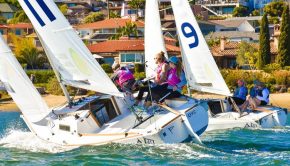Immersion Sailing
Published on May 3rd, 2011
By Nick Hayes, author
You’re probably reading this because you’re a sailor. But imagine that you’re not a sailor. You’ve never done it, but always wanted to. You find a sailing club that supplies all the boats and all the equipment and free training to learn to sail and then use the boats as often as you want for about $25 bucks a month. Sound like a good way to start?
You arrive for your first lesson, pull on a supplied wetsuit, a PFD and a hiking harness and help rig a 15-foot planing dinghy with a high-tech high-roach main, a roller furling blade and an asymmetrical kite on a sprit. You’ve never sailed before, but you’re going to start by driving this turboed machine in a 20-25 knot San Francisco bay breeze.
I saw this happen last summer, while visiting the area talking about Saving
Sailing (note: Nick authored a book by the same name). I was a guest crew on a training sail that was extreme sailing for most, but the first time ever for one of the students on board. In two hours, everyone drove, tacked, jibed, trimmed and hiked. We experienced long stretches of white-knuckle planing and capsized twice, so it was thrilling for me, a thirty-plus year veteran and a sport-boat lover. The instructor was excellent – a calm voice with an eye toward safety and big fun – and the students, one a college kid and the other 70-ish, were ready for more when it was over.
But there is more.
The Cal Sailing Club is everything you don’t expect about a teaching sailing organization. It provides immersion learning at its best, but it teaches far more than sailing skills.
There is no paid staff. Not one. There is no formal class schedule. If you want to learn to sail, you put your name on a calendar for the time that works for you, and a volunteer instructor tries to make the time work, first come, first serve. Volunteer teachers are rewarded for giving their time with reduced membership fees. There is no classroom, so most of the teaching happens on the water. And since it happens aboard these ultra fast boats and in big bay breeze, learning comes fast. It might take a newcomer only a handful of on-water classes to “qualify” to use the club’s boats anytime that they want. Training can go on as long as the student needs it to.
Once a Cal Sailing Club member feels confident enough to take and pass a safety and sailing test, they are not just a member with a right to boats, they are also welcome to take guests, but more importantly, to volunteer to teach other newcomers.
Think about that for a minute: you might have just started sailing a year ago, and now you’re teaching aboard a sailing rocket-ship in what might be called a “small craft advisory” in most parts of the world.
I must report that the Cal Sailing Club is an extreme outlier; they sit either on the farthest bleeding edge of innovation in sailing development and instruction, or, arguably, they do things the way they used to be done. Today’s typical sailing teaching organizations are far more structured, with indoor and outdoor curriculum, set schedules, a more conservative fleet and more docile prevailing weather, and paid professionals and coaches.
While it’s true that you will find excellent sailing graduates from both the super-structured schools and the Cal Sailing Club, this place is special in a radical way. – SpinSheet Magazine, read on








 We’ll keep your information safe.
We’ll keep your information safe.